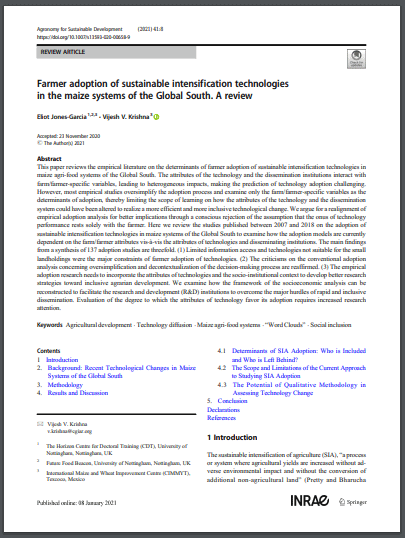This paper reviews the empirical literature on the determinants of farmer adoption of sustainable intensification technologies in maize agri-food systems of the Global South. The attributes of the technology and the dissemination institutions interact with farm/farmer-specific variables, leading to heterogeneous impacts, making the prediction of technology adoption challenging. However, most empirical studies oversimplify the adoption process and examine only the farm/farmer-specific variables as the determinants of adoption, thereby limiting the scope of learning on how the attributes of the technology and the dissemination system could have been altered to realize a more efficient and more inclusive technological change. We argue for a realignment of empirical adoption analysis for better implications through a conscious rejection of the assumption that the onus of technology performance rests solely with the farmer. Here we review the studies published between 2007 and 2018 on the adoption of sustainable intensification technologies in maize systems of the Global South to examine how the adoption models are currently dependent on the farm/farmer attributes vis-à-vis the attributes of technologies and disseminating institutions. The main findings from a synthesis of 137 adoption studies are threefold. (1) Limited information access and technologies not suitable for the small landholdings were the major constraints of farmer adoption of technologies. (2) The criticisms on the conventional adoption analysis concerning oversimplification and decontextualization of the decision-making process are reaffirmed. (3) The empirical adoption research needs to incorporate the attributes of technologies and the socio-institutional context to develop better research strategies toward inclusive agrarian development. We examine how the framework of the socioeconomic analysis can be reconstructed to facilitate the research and development (R&D) institutions to overcome the major hurdles of rapid and inclusive dissemination. Evaluation of the degree to which the attributes of technology favor its adoption requires increased research attention.

